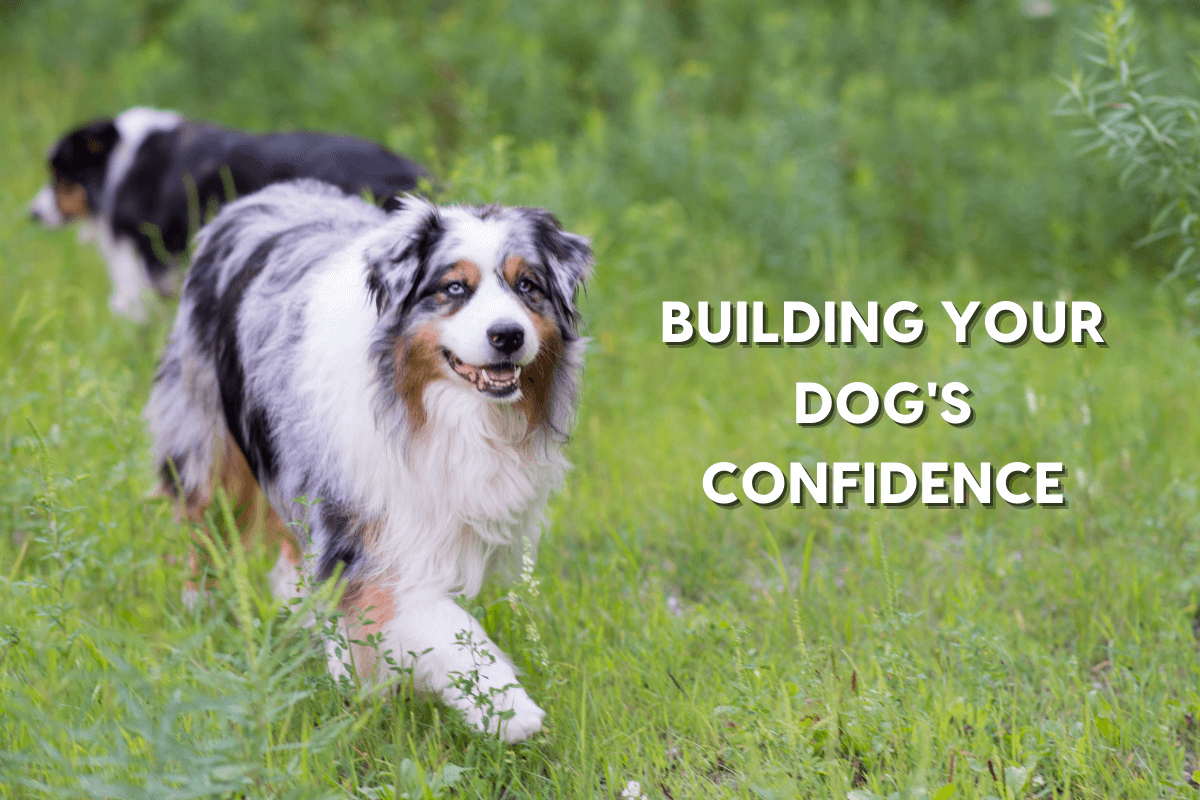Ever observed how a dog’s confidence can flourish with proper training? Dogs, much like humans, thrive when they receive positive reinforcement and feel a sense of accomplishment. Training isn’t merely about instilling good behavior—it’s a fundamental aspect of nurturing a dog’s self-esteem.
The history of dog training roots back centuries, with varying techniques aimed at bolstering a dog’s abilities and confidence. According to a study, 95% of dog owners noticed an improvement in their pet’s self-assurance post-training. This statistic underscores the importance of structured activities and consistent, positive reinforcement in building a dog’s self-esteem.
Effective dog behavior training builds a dog’s confidence by providing consistent learning experiences. Using positive reinforcement, dogs associate actions with rewards, boosting their self-esteem. Socialization and advanced training techniques offer challenges that, once conquered, enhance their resilience. Over time, this structured approach fosters a confident and well-adjusted pet.
How Training Builds a Dog’s Confidence
Training is a powerful tool for building a dog’s confidence. It helps dogs learn new skills and overcome fears. Every successful training session boosts their self-esteem, making them feel capable and valued.
Positive reinforcement is key in training. Praising your dog for good behavior encourages them to repeat it. This creates a cycle where the dog feels good and is more willing to learn new things.
Consistency in training is also crucial. Regular sessions help establish trust between you and your dog. This trust forms the foundation for a confident relationship.
Structured training can include a mix of basic commands, advanced skills, and fun activities. These varied tasks keep the training interesting and challenging. The result is a confident, well-behaved dog that feels secure in its abilities.
How To Build A Dog’s Self-Esteem
The Role of Positive Reinforcement in Training
Positive reinforcement is a cornerstone of effective dog training. This method involves rewarding dogs for good behavior, encouraging them to repeat it. Common rewards include treats, praise, and playtime.
When a dog receives a reward, it links the desired action to a positive outcome. This makes the dog more likely to repeat the behavior. Over time, positive reinforcement can shape reliable habits.
It’s essential to be consistent with rewards. Always reinforce the correct behavior immediately. This helps the dog understand what actions are being rewarded.
Positive reinforcement also strengthens the bond between the dog and the owner. It fosters trust and respect, leading to a more harmonious relationship. A confident dog is often the result of this positive approach.
Establishing Trust through Consistent Training Sessions
Consistent training sessions are key in building trust between you and your dog. It’s about showing your dog that you are reliable and predictable. This fosters a secure environment where your dog feels safe to learn.
Regular training routines help dogs understand expectations. When they know what to expect, they are less anxious and more confident. This consistency reinforces their learning and strengthens your bond.
Using gentle and patient methods is crucial. Yelling or using harsh methods can damage trust. Positive, repetitive interactions during training build a strong foundation of trust.
Make training sessions enjoyable, mixing commands with play. Dogs respond well to fun and engaging activities. Keeping sessions consistent and positive creates a trusting and confident relationship.
Challenges and Rewards: Key Components of Confidence Building
Overcoming challenges is essential for building a dog’s confidence. Each time a dog faces and conquers a new challenge, its self-esteem grows. This process teaches persistence and resilience.
Rewards play a vital role in this journey. They provide motivation and positive reinforcement. Treats, praise, and playtime are effective rewards that can highlight a dog’s progress.
Challenges should be tailored to the dog’s skill level. Gradually increasing difficulty prevents frustration and keeps the dog engaged. It’s important to celebrate small victories to maintain enthusiasm.
Consistency in presenting challenges and providing rewards reinforces learning. This method helps dogs understand the connection between effort and reward. Over time, they learn to approach new situations with confidence.
Owners can use a mix of challenges to keep training interesting. For instance, introducing new tricks or navigating obstacle courses. This variety ensures that the dog remains stimulated and eager to learn.
The Impact of Socialization on Dog Confidence
Socialization greatly influences a dog’s confidence. It helps dogs interact positively with different environments, people, and other animals. This exposure reduces fear and anxiety in unfamiliar situations.
Puppies that are socialized early often grow into more confident adults. Introducing them to various sounds, sights, and experiences makes a big difference. Socialization helps them learn to cope with new stimuli calmly.
Even adult dogs benefit from socialization. Regular interaction with other dogs during walks or playdates can improve their behavior. Socialization prevents aggression and insecurity.
Structured socialization classes can be very effective. These classes allow dogs to practice social skills in a controlled environment. They provide opportunities for positive interactions.
- Encounters with other dogs
- Interaction with different people
- Exposure to new places
The key to successful socialization is consistent, positive experiences. Negative encounters can set a dog back. Encouragement and patience are essential in building a dog’s social confidence.
Advanced Training Techniques to Boost Confidence
Advanced training techniques can significantly enhance a dog’s confidence. Agility training is one such technique. Navigating obstacles like jumps and tunnels can increase a dog’s self-assurance.
Clicker training is another advanced method. This technique uses a clicker sound to mark good behavior, followed by a reward. The clear communication helps dogs understand exactly what is expected of them.
Incorporating problem-solving tasks into training sessions can also be beneficial. Activities like puzzle toys or hide-and-seek games challenge a dog’s mind. They help build confidence by providing a sense of accomplishment.
Advanced obedience training goes beyond basic commands. Teaching tricks like “roll over,” “play dead,” or more complex commands can be fulfilling. These should be taught step-by-step to ensure the dog understands.
Group training sessions add another layer of challenge and reward. Working alongside other dogs helps build social confidence. It also trains the dog to focus amid distractions.
Through varied and consistent advanced training, dogs develop a greater sense of competence. This leads to a happier, more confident pet. Owners, too, benefit from the joy of witnessing their dog’s progress.
Measuring Improvements in a Dog’s Self-Esteem
Tracking progress in a dog’s self-esteem involves observing changes in behavior. A confident dog often shows increased willingness to try new activities. They may also demonstrate less fear and anxiety in unfamiliar situations.
One method to measure improvements is through their interaction with other dogs and people. More social engagement indicates higher confidence levels. Owners can note how often their dog initiates play or interacts calmly with strangers.
A dog that has improved self-esteem might show eagerness during training sessions. Watch for signs of enthusiasm when learning new commands or tricks. Consistent participation and excitement are strong indicators of boosted confidence.
Behavior Indicator Description Initiative in Play Takes the lead in playing with others, showing comfort and ease. Calm Interaction Displays relaxed behavior around new people or dogs. Eagerness in Training Shoots forward to learn commands, demonstrating interest and joy.
Owners can also observe physical clues such as a relaxed body posture and wagging tail. These signals show that the dog feels secure and happy. Regular evaluations help ensure ongoing growth in your furry friend’s self-esteem.
Frequently Asked Questions
Understanding how to build your dog’s confidence through training can be crucial. Here are some common questions and answers to help guide you.
1. Can older dogs gain confidence through training?
Yes, older dogs can gain confidence through training. While they might require a bit more patience and time, using positive reinforcement helps them learn and adapt. Focus on creating positive associations with new experiences to gradually build their self-esteem.
Training can include basic commands to advanced tricks. Consistent, positive interactions boost their confidence over time, helping them become well-adjusted to new situations. The key is to go at their pace and keep the sessions enjoyable and rewarding.
2. How does socialization contribute to a dog’s confidence?
Socialization plays a significant role in building a dog’s confidence. Exposing a dog to various environments, people, and other animals reduces their fear and anxiety. This exposure helps them become more adaptable and less reactive in unfamiliar situations.
Early and consistent socialization is crucial. Positive experiences with different stimuli lead to a more confident and well-rounded dog. However, it’s important to ensure that these interactions are controlled and not overwhelming for the dog.
3. What are some signs of a confident dog?
A confident dog shows relaxed body language, such as a wagging tail and an open posture. They are curious and willing to explore new environments, often greeting new people and animals with ease. Confident dogs also follow commands readily and engage enthusiastically in play and training.
Less confident dogs might exhibit fear or avoidance behaviors, such as cowering or excessive barking. Monitoring these behaviors can help identify areas that need more focus in training. Gradual exposure and positive reinforcement can aid in increasing a dog’s confidence level.
4. What should I avoid when trying to build my dog’s confidence?
Avoid using punishment-based training methods, as these can increase fear and anxiety in dogs. Negative experiences can damage a dog’s trust and hinder their confidence-building process. Instead, focus on positive reinforcement and gentle guidance.
It’s also important to avoid overwhelming your dog with too many new experiences at once. Gradually introducing new stimuli and ensuring every interaction is positive is key to successful training. Patience and consistency are critical factors in helping your dog build confidence.
5. How long does it take to see improvements in a dog’s confidence?
The time it takes to see improvements in a dog’s confidence varies based on the individual dog and their past experiences. Some dogs might show progress within a few weeks, while others may take several months. Consistency in training and positive reinforcement are crucial.
Celebrate small victories and remain patient. Each dog learns at their own pace, and pushing them too quickly can be counterproductive. Regular, positive interactions help build a strong foundation for lasting confidence.
Conclusion
Building a dog’s confidence through training is a rewarding journey. It involves consistent effort, patience, and understanding. Positive reinforcement and socialization play crucial roles in this process.
Over time, these methods help create a confident, well-adjusted dog. Tailoring challenges to their skill level and maintaining regular, positive interactions is key. This approach fosters a trusting and secure bond between you and your pet.


